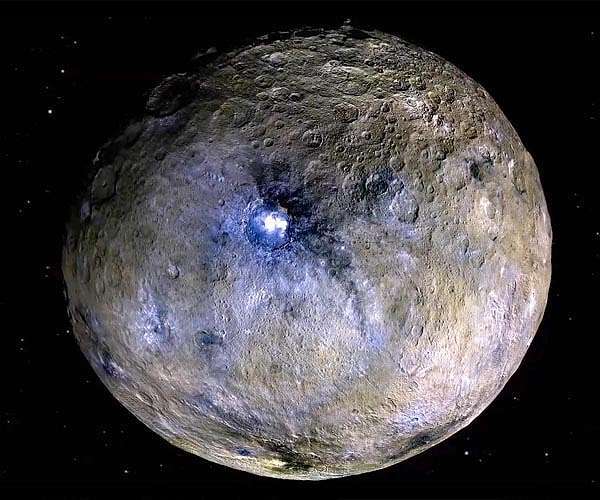5.12.2024

Six years after NASA's Dawn mission completed its historic exploration of Ceres and Vesta, scientists continue to uncover remarkable insights about the largest bodies in the asteroid belt. A recent study led by the Instituto de Astrofisica de Andalucia (IAA-CSIC) reveals eleven new areas on Ceres that suggest the presence of a substantial internal reservoir of organic materials. This finding, based on Dawn spacecraft data, sheds new light on Ceres' origin and potential for harboring life-supporting processes. The results were published in *The Planetary ScienceJournal*.
In 2017, Dawn detected organic compounds near the Ernutet crater, sparking debates about their origins. Initial theories leaned toward exogenous sources, such as impacts from organic-rich comets or asteroids. However, this latest research favors the hypothesis of an endogenous origin, pointing to an internal reservoir protected from solar radiation. "The significance of this discovery lies in the fact that, if these are endogenous materials, it would confirm the existence of internal energy sources that could support biological processes," explains Juan Luis Rizos, a researcher at the Instituto de Astrofisica de Andalucia (IAA-CSIC) and the lead author of the study.
A Window into Solar System History
With a diameter of over 930 kilometers, Ceres is the inner Solar System's most water-rich object after Earth and shares traits with other ocean worlds. It also has ties to carbonaceous chondrites - primitive meteorites containing material from the Solar System's formation 4.6 billion years ago.
"Ceres will play a key role in future space exploration," says Rizos (IAA-CSIC). "Its water, present as ice and possibly as liquid beneath the surface, makes it an intriguing location for resource exploration. In the context of space colonization, Ceres could serve as a stopover or resource base for future missions to Mars or beyond."
Innovative Techniques Unlock Hidden Secrets
The study utilized advanced Spectral Mixture Analysis (SMA) to examine data from Dawn's instruments, including its high-resolution Framing Camera 2 (FC2) and its VIR imaging spectrometer. By integrating high spatial resolution images from the FC2 camera with the VIR spectrometer's high spectral resolution, researchers pinpointed eleven new regions with characteristics indicative of organic compounds.
Most of these regions are located near the equatorial area of Ernutet crater and show evidence of exposure to solar radiation, which degrades organic materials over time. The strongest signals were found in a region between the Urvara and Yalode basins, where organic material appears to have been ejected from deeper layers during impact events. "These impacts were the most violent Ceres has experienced, so the material must originate from deeper regions than the material ejected from other basins or craters," clarifies Rizos (IAA-CSIC). "If the presence of organics is confirmed, their origin leaves little doubt that these compounds are endogenous materials."
Implications for Astrobiology and Future Exploration
Supporting research from Italian collaborators published in *Science* highlights the rapid degradation of organic compounds under solar radiation, suggesting that significant quantities of organic material lie beneath Ceres' surface. This discovery fuels speculation that similar conditions may exist on other celestial bodies, broadening the scope of astrobiological research.
"The idea of an organic reservoir in such a remote and seemingly inert location like Ceres raises the possibility that similar conditions could exist on other Solar System bodies. Without a doubt, Ceres will be revisited by new probes in the near future, and our research will be key in defining the observational strategy for these missions," concludes the lead author of the paper.
Quelle: SD
